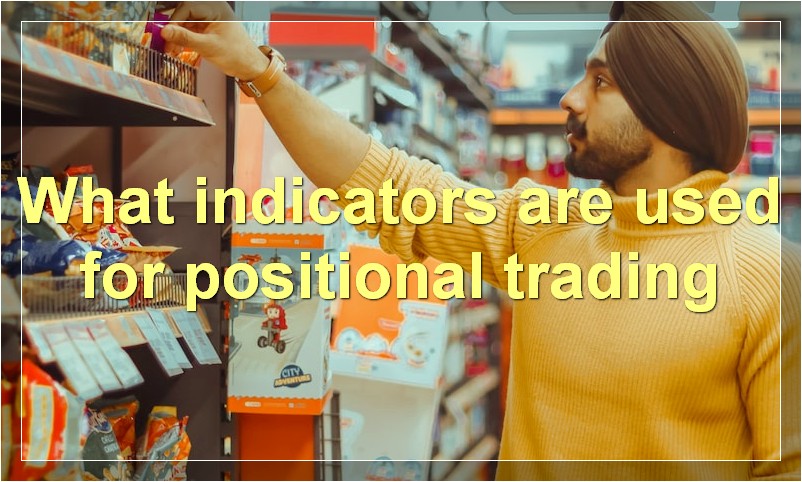If you’re looking to get started in positional trading, then this is the article for you. Here, we’ll cover the basics of what positional trading is, and how you can get started.
What is the definition of positional trading
Positional trading is a type of investment strategy where traders seek to make money by buying and holding onto stocks or other assets for an extended period of time. The goal is to ride out short-term fluctuations in the market and generate profits through long-term price appreciation.
Positional trading can be a viable strategy for investors who are patient and have a long-term outlook. It can also be riskier than other strategies, since it involves holding onto assets during periods of market volatility.
What are the benefits of positional trading

When it comes to trading the markets, there are different approaches that can be taken in order to try and achieve success. Some people may opt for day trading, where positions are only held for a short period of time in an attempt to take advantage of small price movements. Others may choose to swing trade, where positions are held for a slightly longer period of time in an effort to capture larger price swings. And then there is positional trading, which is a strategy that involves holding a trade for an extended period of time in order to profit from long-term trends.
So, what are the benefits of positional trading? Let’s take a look at a few:
1) It can be less stressful than other forms of trading.
If you are someone who gets easily stressed out by the constant action of day trading or swing trading, then positional trading may be a better fit for you. Because you are holding onto trades for longer periods of time, there is less need to constantly monitor the markets and make split-second decisions. This can lead to a more relaxed approach to trading, which can in turn help to improve your overall performance.
2) It can provide greater opportunities for profit.
While day traders and swing traders may only capture small price movements, positional traders have the potential to profit from much larger trends. This is because they give the markets time to move in the desired direction before closing out their trades. So, if you are patient and have faith in your analysis, positional trading could be a very profitable way to trade the markets.
3) It can help you develop a better understanding of the markets.
Because positional traders hold their trades for longer periods of time, they often have a better understanding of the underlying market conditions than shorter-term traders. This is because they have more time to study the charts and observe how prices react over extended periods of time. As such, positional trading can be a great way to gain a deeper understanding of the markets, which can eventually lead to improved trading results.
What are the risks of positional trading
There are a few risks to positional trading that must be considered before taking on this type of strategy. The first is the possibility of a reversal in the market. If the market were to unexpectedly reverse, then all of the open positions would likely be lost. Another possible risk is that of a sudden change in volatility. If the market experiences a sudden change in volatility, it could cause the stop-losses to be hit, and again, all of the positions would likely be lost. Finally, there is always the risk that the trade simply doesn’t work out and the position is not profitable. While this is true of any type of trading, it is especially important to consider when using a positional trading strategy.
What is the difference between day trading and positional trading
Day trading is the buying and selling of a security within the same day. Positional trading is a longer-term strategy where you buy a security with the intention of holding it for a period of time, regardless of day-to-day price fluctations.
What is the best time frame for positional trading
Positional trading is a strategy where traders take a long-term view of the market and hold their positions for an extended period of time. The goal of positional trading is to capture large market moves or trends. Positional traders typically hold their positions for days, weeks, or even months.
The best time frame for positional trading depends on the trader’s goals and objectives. Some traders may hold their positions for only a few days, while others may hold them for several months. The key is to find a time frame that works best for your trading style and goals.
If you’re looking to capture large market moves, you may want to hold your positions for weeks or even months. However, if you’re looking to take advantage of shorter-term trends, you may want to hold your positions for only a few days. Ultimately, it’s important to find a time frame that fits your trading style and goals.
What indicators are used for positional trading

There are a few different indicators that can be used for positional trading. Some common ones are the moving average, Bollinger Bands, and MACD. These indicators can help you to identify entry and exit points, as well as potential areas of support and resistance.
How do I develop a positional trading strategy
position trading is a strategy where traders take a long-term view of the market and hold their positions for an extended period of time. This strategy can be used in any market, but is most commonly employed in the forex market.
When developing a positional trading strategy, the first step is to identify the overall trend of the market. This can be done by using technical analysis tools such as trend lines, moving averages, and Fibonacci retracement levels. Once the trend has been identified, the trader can then look for opportunities to enter the market in the direction of the trend.
Once a trade has been entered, the trader will then need to manage their position. This includes setting stop-losses and taking profits at predetermined levels. Position trading is a more passive form of trading, so traders will need to be patient and let their profits run.
If you are new to trading, then developing a positional trading strategy can be a great way to get started. By taking a long-term view of the market, you can limit your risk and give yourself time to learn how the market works.
What are some common mistakes made in positional trading
1. One of the most common mistakes made in positional trading is over-trading. This occurs when a trader takes on too many positions, or trades too frequently, and as a result, their account becomes overextended and they start to incur losses.
2. Another mistake that is often made is failing to properly manage risk. Positional trading can be a risky proposition, and if a trader does not properly manage their risk, they can quickly find themselves in a losing position.
3. Finally, another mistake that is often made is not having a clear exit strategy. When positional trading, it is important to have a clear plan for how you will exit your trades, as this can help you to minimize losses and maximize profits.
What are some tips for successful positional trading
There is no one-size-fits-all answer to this question, as the best tips for successful positional trading will vary depending on the trader’s individual goals, risk tolerance, and investment horizon. However, some general tips that may be helpful for positional traders include:
1. Define your goals and objectives for positional trading upfront, and stick to them.
2. Have a well-defined exit strategy before entering into any trade.
3. Manage your risk carefully by using stop-loss orders and position sizing.
4. Be patient and disciplined in your approach, and don’t let emotions influence your decisions.
5. Stay up-to-date on market news and developments that could impact your positions.
6. Use technical analysis to help you identify potential entry and exit points.
7. Keep a journal of your trades to help you learn from your successes and failures.
Is there a difference between long-term and short-term positional trading
There are a few key differences between long-term and short-term positional trading. Firstly, long-term trades are usually based on larger timeframes such as the daily or weekly chart, while short-term trades are usually based on smaller timeframes such as the 1-hour or 4-hour chart. Secondly, long-term trades usually have wider stop-losses and take-profits, while short-term trades usually have tighter stop-losses and take-profits. Finally, long-term traders tend to focus more on the fundamental analysis of a market, while short-term traders tend to focus more on technical analysis.

